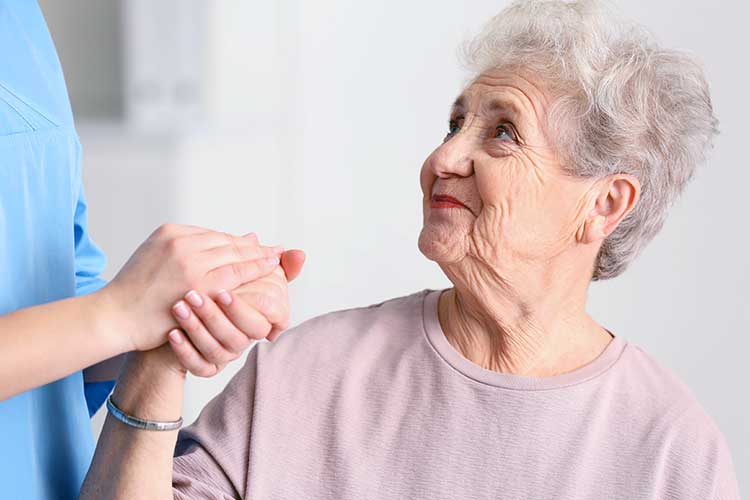Physical restraint is an ethically, legally and clinically harmful practice that violates a client’s fundamental human rights and may lead to poor care outcomes (Health.vic 2022).
What is Physical Restraint?
Physical restraint is the practice of intentionally restricting or subduing the movement of a client’s body through the use of physical force, for the purpose of influencing their behaviour (ACQSC 2021).
Examples of physical restraint include pinning a client down, holding them into a certain position to forcibly perform person care or administer medicine, or physically moving them away from somewhere they want to go (ACQSC 2021).
While physical restraint has been used in the past for the purpose of managing changed behaviours or preventing falls, evidence suggests that physical restraint may actually worsen changed behaviours and does not reduce the risk of falls (Health.vic 2022).
Physical restraint is a type of restrictive practice. Restrictive practices are potentially harmful and must only be used as a last resort intervention, in their least restrictive form (ACQSC 2021).
In 2021-2022, there were 16,996 physical restraint events recorded in acute hospitals in Australia (AIHW 2023).
Physical Restraint in the National Safety and Quality Health Service Standards
Physical restraint is outlined in Action 5.36 of the National Safety and Quality Health Service Standards, under Standard 5: Comprehensive Care.
This action aims to minimise the use of physical and mechanical restraint in healthcare, and consequently, the harm incurred by clients. Providers are required to meet the following guidelines:
- The use of physical and mechanical restraint is minimised and eliminated if possible
- Physical and mechanical restraint are used in accordance to legislation
- Any use of physical or mechanical restraint is reported to the governing body.
(ACSQHC n.d.)
Requirements for the Use of Physical Restraint
In some circumstances, the use of restrictive practices may be necessary. In these situations, restrictive practices must only be used as a last resort, in the least restrictive form, and, for the shortest amount of time (Health.vic 2021).
Healthcare services must meet the following strict requirements in order for physical restraint to be used lawfully:
- Physical restraint must only be used as a last resort in preventing harm to the client or others, after considering the likely effect on the client.
- An approved health practitioner or an authorised psychiatrist who has ongoing knowledge of the client must assess them as posing a risk of harm to themselves or others, assess physical restraint as necessary, and fully document these assessments.
- Best-practice alternative strategies to seclusion and other must be attempted first and documented, along with why they were not successful.
- The physical restraint must be:
- Proportionate to the perceived risk of harm
- Used in the least-restrictive form, and
- Used for the shortest amount of time possible.
- The need for, use of, and effectiveness of the physical restraint must be continuously monitored for:
- Distress
- Harm
- Adverse events
- Changes in wellbeing
- Ability to perform daily activities.
- The use of physical restraint must be reviewed and documented at a frequency determined by organisational policy and in accordance with the law in their jurisdiction.
- Informed consent must be obtained from the client (or their restrictive practices substitute decision-maker in a case where the client does not have the capacity to give consent) in accordance with the law in their jurisdiction. The use of any restrictive practice must take into consideration the needs of people from Aboriginal or Torres Strait Islander and Cultural and Linguistically-Diverse backgrounds.
- Physical restraint must be used in accordance with:
- The National Safety and Quality Health Service Standards
- Relevant state or territory legislation
- Relevant provisions set out in the client’s behaviour support plan, if applicable.
(Health.vic 2014, 2015, 2021; NDIS 2023)
Note: Legislation and regulations on physical restraint and other restrictive practices varies between states and territories. However, in all states and territories, physical restraint is strictly a last resort and is only to be used if there are no other options.
Physical restraint should never be used:
- As a therapeutic intervention
- In response to boredom
- In response to illness
- In response to anxiety or distress
- To compensate for staff shortages
- As a substitute for less-restrictive alternatives
- As punishment, threat or discipline
- For the convenience of staff.
(Health.vic 2013)
Impacts of Physical Restraint on the Client

Physical restraint can have a variety of severe, adverse consequences on clients, including:
- Cuts and bruises
- Falls
- Loss of strength
- Pain
- Constipation
- Incontinence
- Malnutrition
- Pressure injury
- Feelings of panic, fear or anger
- Mood changes (e.g. anger, withdrawal, aggression)
- Confusion
- Anxiety
- Depression
- Loneliness and isolation
- Loss of dignity
- Distress for family members
- Distrust between clients, their loved ones and staff
- Serious injury
- Death.
(My Aged Care n.d.; Health.vic 2016)
Preventing Physical Restraint
There are three main ways in which you can minimise the need for physical restraint and other restrictive practices:
- Provide a respectful and welcoming service environment to ensure the client feels safe and comfortable.
- Identify and address behavioural changes before they escalate.
- Reduce falls risk through alternative safety measures before the need for restraint arises.
(Health.vic 2022)
In general, health service organisations should:
- Recognise behavioural changes when they occur and identify clients who may be at risk of requiring physical restraint.
- Conduct a comprehensive assessment of each client and develop an individualised plan if any risk factors are identified. The assessment should include:
- Cognitive assessment
- Medical history
- Responsive behaviours (for clients with dementia)
- The client’s routines, preferences and values
- Pain assessment
- Communication ability
- Delirium
- Medications
- Mental state
- Falls risk
- Psychosocial needs
- Physical environment.
- Refer the client to other services (e.g. general practitioner, physiotherapist) if deemed necessary.
- Assess the client and the interventions that have been decided on an ongoing basis.
- Involve the client and their family in the process of developing and implementing strategies.
- Ensure staff are adequately trained in the ethics of physical restraint and possible alternatives.
- Recognise situations that may cause clients to become distressed, anxious or aggressive.
- Consider staffing clients one-on-one to ensure safety and supervision is increased until their underlying condition is identified and treated appropriately.
(Health.vic 2022; Queensland Health 2016)
Providing a Respectful and Welcoming Service Environment
The following are some practical suggestions for caring for clients in a way that will help reduce changed behaviours.
- Ensure you deliver trauma-informed care that takes into account the client’s past traumatic experiences. Make sure they feel welcome and provide them with options so that they do not feel trapped.
- Engage with the client and develop a therapeutic relationship with them.
- Always deliver person-centred care.
- Be polite and respectful, and practice empathetic listening.
- Meet the client’s immediate needs.
- When speaking to a client, be calm, introduce yourself, use their preferred name and provide verbal reassurance.
- Practice effective and empathetic communication; validate the client’s concerns.
- Provide the client with access to a range of meaningful activities they can choose from.
- Align the client’s routine with what they are used to (e.g. shower and sleeping patterns).
- Respect the client’s communication needs.
- Use non-threatening behaviour and body language.
- Do not invade the client’s personal space.
- Inform the client in advance before you do anything.
- Consider the client’s values and preferences.
- Give the client capacity to make choices or suggest alternatives.
- Apologise if the client is upset (if reasonable).
(SA DoH 2015; Health.vic 2022)
Identifying and Addressing Behavioural Changes

This involves recognising anxiety, which is the first sign of behavioural change, and addressing the client’s distress. If the situation escalates, you may need to use de-escalation strategies.
Read: Minimising Restrictive Practices: Seclusion
Reducing Falls Risk
The following strategies may be implemented to reduce the risk of falls so that physical restraint is not necessary:
- Use equipment such as low beds, non-slip mats and hip protectors
- Ensure the service environment is secure, well-lit and safe for wandering
- Address health issues such as mental health conditions, sensory loss, poor balance or unstable blood pressure.
(My Aged Care n.d.)
Emergency Use of Physical Restraint
It is essential to refer to your state or territory’s legislation when deciding a client needs to be physically restrained. As a general guideline:
- Physical restraint must only be implemented by staff members who have been appropriately trained.
- Physical restraint will need to be authorised by the relevant party. This depends on your state or territory.
- Most states and territories require certain parties to be notified in the event of physical restraint.
- Physical restraint should only occur for the minimum amount of time necessary. There may be time limits and extension provisions depending on your state or territory.
- The client should be observed while being physically restrained.
- The client should be debriefed after the incident.
(SA Health 2015; ACSQHC n.d.)
Conclusion
Physical restraint and other restrictive practices are interventions that should only be used as a last resort in the event of a behavioural emergency.
Remember that these practices are highly distressing for the client and may cause or exacerbate trauma. The goal is to minimise and hopefully prevent restrictive practices as much as possible.
Always refer to your state or territory’s legislation, as well as your facility’s policies and procedures.
Test Your Knowledge
Question 1 of 3
True or false: Physical restraint has been shown to decrease the risk of falls.
Topics
References
- Aged Care Quality and Safety Commission 2021, Overview of Restrictive Practices, Australian Government, viewed 7 August 2023, https://www.agedcarequality.gov.au/sites/default/files/media/overview-of-restrictive-practices_0.pdf
- Australian Commission on Safety and Quality in Healthcare n.d., Action 5.35, Australian Government, viewed 7 August 2023, https://www.safetyandquality.gov.au/standards/nsqhs-standards/comprehensive-care-standard/minimising-patient-harm/action-535
- Australian Institute of Health and Welfare 2023, Seclusion and Restraint in Mental Health Care, Australian Government, viewed 7 August 2023, https://www.aihw.gov.au/mental-health/topic-areas/restrictive-practices
- Chieze, M, Hurst, S, Kaiser, S & Sentissi, O 2019, ‘Effects of Seclusion and Restraint in Adult Psychiatry: A Systematic Review’, Front Psychiatry, vol. 10 no. 491, viewed 7 August 2023, https://www.ncbi.nlm.nih.gov/pmc/articles/PMC6673758
- Health.vic 2016, Physical Restraint: Information for Residents, Family and Carers, Victoria State Government, viewed 7 August 2023, https://www.health.vic.gov.au/sites/default/files/migrated/files/collections/factsheets/h/health-literacy-physical-restraint.pdf
- Health.vic 2022, Physical Restraint: Standardised Care Process, Family and Carers, Victoria State Government, viewed 7 August 2023, https://www.health.vic.gov.au/sites/default/files/2022-12/standardise-care-physical-restraint.PDF
- Health.vic 2021, Restrictive Interventions – Bodily Restraint and Seclusion, Victoria State Government, viewed 7 August 2023, https://www.health.vic.gov.au/practice-and-service-quality/restrictive-interventions-bodily-restraint-and-seclusion
- Department of Health 2023, Restrictive Interventions, Victoria State Government, viewed 7 August 2023, https://www.health.vic.gov.au/mental-health-and-wellbeing-act-handbook/treatments-and-interventions/restrictive-interventions
- Health.vic 2015, Reducing Restrictive Interventions, Victoria State Government, viewed 7 August 2023, https://www.health.vic.gov.au/practice-and-service-quality/reducing-restrictive-interventions
- Health.vic 2013, Reducing Restrictive Interventions: Literature Review and Document Analysis (2013), Victoria State Government, viewed 7 August 2023, https://www.health.vic.gov.au/publications/reducing-restrictive-interventions-literature-review-and-document-analysis-2013
- My Aged Care n.d., Quality Measures in Aged Care, Australian Government, viewed 7 August 2023, https://www.myagedcare.gov.au/quality/quality-measures-aged-care
- Queensland Health 2016, Physical Restraint, Queensland Government, viewed 7 August 2023, https://www.health.qld.gov.au/__data/assets/pdf_file/0027/465174/cpp-physical-restraint.pdf
- SA Health 2015, Restraint and Seclusion in Mental Health Services Policy Guideline, Government of South Australia, viewed 7 August 2023, https://www.sahealth.sa.gov.au/wps/wcm/connect/5dd2f58048f79928929df70e3d7ae4ad/Guideline_restraint+and+seclusion_july2015.pdf?MOD=AJPERES&CACHEID=5dd2f58048f79928929df70e3d7ae4ad
Additional Resources
- Action 5.35 Minimising Restrictive Practices: Restraint | ACSQHC
- Physical Restraint: Standardised Care Process | Health.vic
- Behaviour Management and BPSD | Ausmed Article
- Minimising Restrictive Practices: Seclusion | Ausmed Article
- Restrictive Practices: Chemical Restraint in Australia | Ausmed Article
- Minimising Restrictive Practices in Healthcare Settings | Ausmed Training Module
 New
New 
